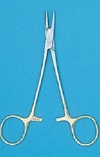CAL 1: Principles of aseptic and operative technqiue Flashcards
Give the NRC classification for a cystotomy with UTI
Contaminated Give prophylactic ABs Therapeutic post-op for established infection UTI should be resolved prior to elective procedures
Give the NRC classification for an elective OVH, 6 month old bitch
Clean-contaminated No ABs
Give the NRC classification for small flank excision of middle aged dog
Clean - no ABs (quick procedure and area can be prepped aseptically)
Give the NRC classification for an ex lap in a dog with dehisence of an intestinal anastomosis –> peritonitis
Dirty Therapeutic ABs (confirm diagnosis via abdominal fluid aspiration but start empirical ABs and change later if needs be)
Give the NRC classification for an ex lap with pancreatic biopsy
Clean No ABs (clean + short)
Give the NRC classification for removal of FB from SI with subsequent spillage of intestinal contents
Contaminated (without spillage = clean-contaminated) Prophylactic ABs
Give the NRC classification for amputation of a cat’s tail following traumatic sacro-coccygeal luxation
Clean - no ABs No open wound, close to anus BUT shouldn’t affect outcome if aseptic procedure is performed correctly
Give the NRC classification for full thickness SI biopsies taken at laparotomy
Clean-contaminated Yes/no to giving prophylactic ABs. A first class surgeon wouldn’t use them in a healthy patient. Decision influenced by patient risk factors and surgical wound factors
Give the NRC classification for lateral wall resection of the external ear canal in a dog with otitis externa
Contaminated Give prophylactic ABs - difficult to prepare ear canal aseptically to same effect as skin elsewhere. May have inflammation and established infection (=dirty) but this is elective so treat pre-existing infection before surgery
Give the NRC classification for SC abscess after a bite wound in a cat
Dirty Therapeutic ABs (an abscess is an established infection). with adequate lancing, draining and lavage, the wound may heal without AB therapy being mandatory
Give the NRC classification for placement of a cystotomy tube in a bitch with urethral obstruction
Clean-contaminated Yes/No prophylactic ABs - post-op AMs aren’t indicated since there will be contamination of the bladder from the presence of the cystotomy tube and use of AMs will simply select for resistant bacteria.
Give the NRC classification for open fracture in radius of dog repaired the day after trauma
Dirty An open traumatic wound of >4-6 hours = dirty. With appropriate AB use and local wound care, wound infection should be no more likely than if a closed fracture were present.
When is the most useful time to take a wound sample (from a microbiologists point of view)?
after wound debridement, fracture fixation and lavage.
Give the NRC classification for placement of a lateral retinacular suture for stabilisation of the stifle after CCL rupture, performed by an experienced surgeon
Clean - no ABs Should be <60-90 minutes (experienced surgeon)
Give the NRC classification for a dog with a traumatic laceration wound 2 hours previously when jumping a barbed wire fence
Contaminated Give prophylactic ABs With appropriate local wound care, post-op therapeutic ABs NOT required. En bloc debridement of wound would convert it to a clean wound for which no AM use is appropriate
What are the 2 types of debridement?
En bloc and layered
Describe en bloc debridement
in areas where there is adequate normal tissue to allow closure after, the whole affected tissue can be excised with a border of healthy tissue. This is ideal for the trunk and proximal limb where there is plenty of available skin to close the deficit.














